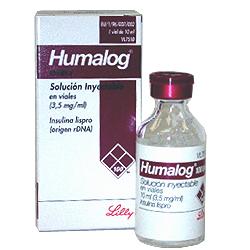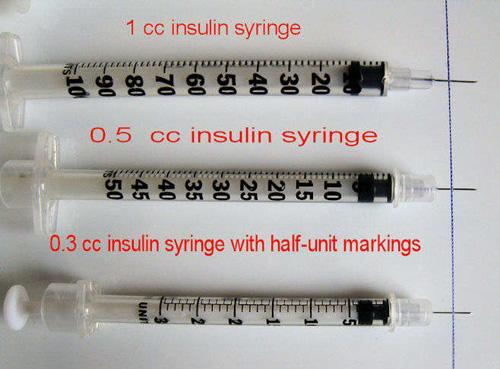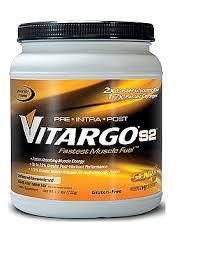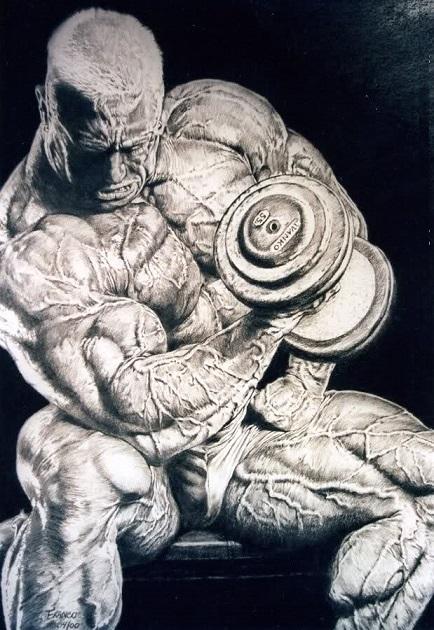Insulin
Insulin is used by diabetics to be able to live a normal life. In order to utilize the glucose (energy) found within the carbohydrate-laden foods we consume, insulin must be present to facilitate its (glucose) absorption. Insulin also plays an essential role in fat and protein metabolism. But I won’t bore you with that. This blog-post is meant for insulin’s role in bodybuilding. It’s used as a bridge drug with GH, for dieting (ketosis) but mostly for bulking.
Many people say that insulin ruined bodybuilding. Well the same is said about Synthol. We all agree that these compounds will stay in bodybuilding, because they have their use. In my opinion insulin is especially useful for the skinny and the hardgainer. If you are a beginner you will have no use for insulin until you reach a plateau. Many people also think that you can achieve more by manipulating your endogenous insulin. That’s also why people believe endogenous growth hormone is superior to exogenous (injected) GH and use secratogogues. In case of insulin that is done with by means of eating high glycemic foods like white rice. Some people blame Dan Duchaine of introducing insulin in bodybuilding, others Tim Belknap, but most of them blame Milos Sarcev. More on that on the end of the blog-post.
It is important to realize the POWER of insulin. Many describe it as the most anabolic hormone in the human body. It has no doubt been a factor in increasing appetite and the effectiveness of growth hormone, therefore, resulting in added muscle growth. However, insulin is not for everyone. It can be very dangerous if you are not aware of the many variables that go along with injecting insulin. One day of being irresponsible with your insulin dose could be potentially fatal. Take your time to educate yourself on diet, different types insulin, and the role of insulin in the human body before you take on the responsibility of adding insulin to your current bodybuilding “bag of tricks”. The risk may not be the worth the reward in some cases. So, know all the facts before trying Insulin.
Risk reduction advice
Insulin can be very risky if you do not know what you are doing. If you have the mentality that MORE IS BETTER, I recommend avoid even trying insulin. This hormone can be potentially fatal if taken recklessly, because normal blood sugar is 70-120 mg/dl. If your blood sugar falls below 20 mg/dl you run the risk of permanent brain damage, coma, or even death. Insulin can kill you quick. I’m talking about a dirt nap within a couple hours if you’re not careful. HOWEVER, there are really only a couple ways you can fuck it up.
The biggest way to fuck up insulin is incorrect measurement. A "unit" is how insulin is measured . If I tell you to take 5 units of insulin and you load up 5cc’s as you would a steroid shot, or even load up 5 units as you would a GH shot, you are probably going to die. 5 units of insulin means 5 tiny little lines or “clicks” on an insulin syringe. It will look like hardly anything in the needle, this is powerful shit and it doesn’t take much at all to do its job..
Every 5 lines on the insulin syringe is boldy marked with a number (5, 10, 15, etc). Here's an example (a 1/2 cc insulin syringe) The very top long unmarked line is zero. The little unmarked line under that is 1 unit. The next little line is 2 units, the next is 3 units, the next is 4 units, then it is the slightly longer bold line marked as 5, then the next line is 6, etc all the way up to the line marked 50
Some U100 insulin syringes even have markings for every half unit.

Eating carbs
The second biggest way to fuck up insulin is to not eat properly after administering it. As a general rule, for every 1 unit of insulin you inject, you need to take 10 grams of carbohydrates with it. This needs to be done within 15 minutes of injecting insulin. Depending on what type of insulin you use, you will want another meal within 60-90 minutes after that, and that will be a solid meal including healthy fats, proteins, and carbs. After getting familiar with insulin and how your body reacts to it, you may find you can change the ratio to 7 grams carbs/ unit of insulin, or may need to raise it slightly, but for a first time insulin user, 10 grams/unit minimum, and err on the side of overkill at first.
Human plasma only contains about 5 grams of carbohydrate at any one time. Diabetics that have taken too much insulin can usually get their blood sugar levels back into normal range by consuming as little as five grams (only 20 calories!) of dextrose. If that is the case, then how did we arrive at the 10-gram per IU rule?
Different types of insulin
The first type of insulin, and the one most commonly used is HUMULIN-R. Humulin R can be purchased from a pharmacy without a prescription for around $20-30 a vial. That’s right, anyone off the street can walk into a Wal-mart pharmacy and buy Humulin-R. This is an insulin with a 30 min-1 hour onset, a 2-5 hr peak, and a 5-8 hr duration. This makes it a little more unpredictable than a faster insulin, because there is a much larger gap as to when it can peak. You could eat a meal with adequate carbs and then 3 hrs later you’re feeling hypo and you better get more in you. But for purchasing/legality issues this is what most guys use. This is an insulin I would not recommend using more than 1x/day. I’d use it post workout and make damn good and sure you’re not using it within 4-5 hrs of bedtime. You want to be awake with this stuff so you can deal with any issues that are coming on from it.
The next type of insulin we will talk about is HUMALOG/NOLVALOG. Humalog and Nolvalog are the same type of insulin, just different brand names. This is a faster acting insulin with a 15 minute onset, 30-90 minute peak, and 3-5 hr duration. This is an insulin that you can shoot more than once/day, 2-3x/day injections are fine, but you need to be cautious of insulin stacking. “Stacking” is when you take an injection, then take another injection say 3-4 hrs later, and even though you measured out x amount of units, it was really like x+3 units because there was some residual left from your last shot. What can happen is you misjudge carb intake and you think you had adequate carbs, but you really fell short and can start getting hypo (dangerously low blood sugar) I would recommend using humalog or nolvalog over humulin R, it’s a faster onset, peak, and a shorter duration. You can know what to expect from it a little easier than Humulin R. Also, being able to use it 2-3x/day will keep you more anabolic and provide better gains.
Next we get into our long acting insulins, or 24 hr insulins. LANTUS/ LEVEMIR- These are the mack fucking Daddy’s of insulins. You want some huge gains? Then run a slower acting basal insulin behind a faster one such as nolvalog or humalog. There is no peak with Lantus, its release is slow enough that your body adjusts to it before any side effects. It’s the safest insulin you could use. Levemir is similar, but has a slight peak at 6-8 hrs, but nothing noticable in most cases. These insulins are usually shot before bedtime, with a 1.5 hr onset, no peak (slight w/ levemir, but not Lantus) and a 20-24 hr. duration. This means you’re anabolic all the time.
Eating on insulin
First off, I would highly advise against using insulin while strictly dieting. You just put yourself in a very dangerous state with lower nutrients and calories on insulin. Not to mention, it is easier to put on bodyfat with insulin if you’re not careful. I just don’t see the benefit of using it while cutting body fat.
While using insulin, every few hours you should have a protein/carb source. We are not doing anything like intermittent fasting, or carb backloading here. You will feed your body on a regular basis throughout the day! Post injection of insulin should be 10 grams carbs per every unit of insulin. WITHIN 15 MINUTES OF SHOT. And remember, with HUMULIN-R, another meal with 40-60 grams carbs, 40-60 grams protein, and SOME healthy fats should be eaten 60-90 minutes from that.
Usage
Insulin is used in a wide variety of ways. Most bodybuilders choose to use it immediately after a workout or first thing in the morning. There are many theories as to what the best dosages of insulin in a non-diabetic are. First, it is probably best to use regular insulin. First-time users should start at a low dosage and gradually work up. For example, first begin with 2 IU and then increase the dosage by 1 IU every consecutive shot. This will allow the bodybuilder to safely determine a correct dosage.
Another method for determining how much insulin to take is to use carbohydrate counting. Diabetics have been doing this for years. 1 unit of insulin covers approximately 10 grams of carbohydrate in men and 10 to 15 grams in women. Therefore, if you eat 2 cups of cooked oatmeal (60 grams of carbohydrates), then you would need 6 units of regular insulin.
Insulin dosages can vary significantly among individuals and is dependent upon insulin sensitivity and the use of other drugs. Bodybuilders using growth hormone and thyroid will have higher insulin requirements, and therefore, will be able to handle higher dosages.
Humulin -R should be injected subcutaneously only with a U-100 insulin syringe.
It is currently the trend to take insulin first thing in the morning with food and your daily injection of growth hormone. Always remember to consume carbohydrates and protein following your insulin and GH injections. Some athletes find this application of insulin very beneficial for putting on mass, while others will tend to put on excess fat using insulin in this manner. Every person’s metabolism is different, therefore, a blood glucose monitor would be prudent to make sure your blood sugar isn’t dropping to quickly. Many bodybuilders take creatine monohydrate with their morning meal and insulin injection since the insulin will help to force the creatine into the muscles.
Many athletes will get sleepy after injecting insulin. This may be a symptom of hypoglycemia, therefore, the person should probably consume more carbohydrates with their morning meals. Avoid the temptation to go to take a nap since the insulin may take its peak effect during sleep and significantly drop glucose levels. Humulin R usually remains active for only 4 hours with a peak at about two hours; therefore, athletes should stay awake for the 4 hours after injecting. Humalog has become popular in bodybuilding circles because of it ultra fast action and short duration. It does its job within 1 hour, and then within 3 hours it is almost completely out of your system, thereby, reducing the chances of hypoglycemia. Humalog is only available with a prescription unlike other types of insulin that can be purchased over-the-counter.
Injecting insulin 30 minutes prior to the end of your workout is a dangerous practice. Bodybuilders do this because when reading the package insert of regular insulin, it clearly states wait ½ hour after injection of Regular insulin before eating. This is true if you are sedentary and do not produce any insulin. For the bodybuilder who carries a great deal of muscle and already produces insulin, regular insulin works much faster. The more muscle you have the more sensitive to insulin your cells will be. This is why Humalog can pack quite a punch on the already insulin-sensitive bodybuilder.
Some athletes have been known to inject a few IUs of insulin before lifting to improve their pump. This practice is extremely risky and best left to athletes with experience using insulin. It is also relevant to note
that muscle repair and growth begins in the hours and days following heavy exercise. It is doubtful that the use of insulin just prior to a workout will have any anabolic effects at this time. However, use of insulin prior to a workout will certainly expose you to a much greater risk of serious harm.
Effective Dose: 1 IU per 10-15 grams of carbohydrate, or 1 IU of insulin for every 20lbs of lean body weight. If someone weighs 300 pound (with 50 pounds of fat), calculate insulin requirements based on 250 pounds (7.5 units per day).
Variables to consider when taking insulin:
• The type, amount and timing of food consumed
• Glycemic index (the glucose elevating effect) of the food consumed
• Body weight
• Timing of insulin administration in relation to food intake and exercise
• Individual variation: Two different people, even if they are of a similar height, weight and other personal characteristics, can respond in a very different way to a given dose of insulin.
Always be near sugar and food
Hypoglycemia (insulin shock) is a state in which blood glucose levels are too low. It is a common and potentially fatal reaction experienced by insulin users. Before a bodybuilder begins taking insulin, it is critical that he or she understands the warning signs and symptoms of hypoglycemia (cold, clammy, shaky, and nauseous)
If you experience any of those warning signs, immediately consume a food or drink containing sugar (such as candy or a carbohydrate drink). This will treat mild to moderate hypoglycemia and prevent a severe state of hypoglycemia. Severe hypoglycemia is a serious condition that may require medical attention. Symptoms include disorientation, seizure, unconsciousness, and death. In some cases an injection of glucagons (a pancreatic hormone which raises blood glucose) may be necessary if the person becomes unconscious and is unable to consume a sugar beverage.
Actually, make sure it’s on you!! If you start feeling sweaty, irritable, cold sweat, dizzy, shaky, hungry, thirsty, just know you’re probably going hypoglycemic and you better eat some simple sugars pretty fucking fast!!!
Buy a glucosemeter
These are fairly easy to use and it’s good to know what your glucose levels are anyways, but even more so when using insulin. The electronic strips that you use with the meters are a onetime deal, they usually come in bottles of 50 strips. I’m not exactly sure if you need a Dr. script to get the strips or not, but I’d suggest going to your Doctor and asking him to write you a script for the diabetic test strips. Just tell your Dr. that you would like to start monitoring your glucose levels on a regular basis. Any Doctor should write a script for that. And you can also buy them on the internet.
4-6 weeks on insulin
You do not want to turn yourself into a diabetic, therefore 4-6 wks max!! It’s also difficult not to accumulate SOME BODYFAT on insulin. I’d follow it up with at least 12 wks off. Humulin-R, nolvalog, and humalog can be used only on days you train if you prefer, this would probably be better so your body does not get too accustomed to it. Now with the 24 hr insulin’s like Lantus and Levemir, those you will need to take every day.
Tim Belknap 
Tim was a diabetic and openly discussed his use of insulin and how it helped him control his blood sugar and build his physique. In 1981 he won the Mr. America only 21 years old. He competed in in the light heavy class, that’s under 90 kg (198lbs) being 5'4" tall. In the early 1980’s he dominated contests, but later he actually was placed down as being “too blocky” . By today’s standards he would be aesthetic and trimmed.
He looked very strong and hard with a giant neck. He had a lot of coverage in the magazines. A bit later he weighed up to 245 lbs with a contest weight of 220 lbs.
Some say the bodybuilding world took notice and realized the power of insulin
Chad Nicholls
One program which took a big step forward around the turn of the millennium and which was widely acceptance by both pro and amateur bodybuilders alike was a method originally devised by Chad Nicholls. It involved using insulin 3X daily, but only 2 days per week for a total of 6 weekly injections. These injections were administered on a bodybuilders training days; particularly when training a weaker bodypart. Chad did not like dextrose, instead preferring to have his clients consume a combination of protein, complex carbs, and simple carbs post-injection. As a result, his athletes enjoyed greater muscle fullness and enhanced protein synthesis in comparison to those who relied solely on dextrose. Chad was also one of the first gurus to address the issue of self-inflicted insulin resistance in relation to exogenous insulin use and develop a program specifically designed to stave off this deleterious effect.
As research continued to demonstrate the importance of pre and post-workout nutrition, many insulin proponents took note and began developing programs which placed greater emphasis on maximizing nutrient delivery during this critical time period. Milos Sarcev was one of the first well known coaches to expound on this idea and devise an entire training program around the use of pre/intra/post workout nutrition in conjunction with insulin.
Milos Sarcev about Insulin use
--------------------------------------------------------------------------------
Humalog is insulin of my choice as well – it’s easiest to control, fastest in action and almost “designed” for post workout period for all the athletes (bodybuilders).
While many question the theory of windows of opportunity – I think it is vast amount of evidence that physiological preference of body trashed by intense weightlifting session (stress) is to take care of shock that just occurred (i.e. replacement or supercompensation of nutrients lost in process).
Action of Humalog is ideal in this event.
Onset is 15 minutes upon intake, peak is within 45 and 75 minutes later, strong action start’s diminishing 2 hours after the intake and it’s completely out within 4 hours.
Only true variable is curve after 2nd hour until the 4th (for some it drops dramatically fast and for some it is slow drop, which means that some insulin might linger in blood stream up until the 4th hour…).
But, assuming that our blood glucose level is quite reduced during the training we should make sure to use adequate amount of fast GLUCOSE delivering carbohydrate source – shortly after injection (IMO – 15 minutes later).
If we are using pure Glucose (dextrose) – we can expect that glucose would take only minutes (2-4) to get in the blood stream and it would peak within 40 minutes (almost identical to Humalog curve). So, my suggestion is to take HALF of the initial mix of ideal post workout nutrients (glucose/fast absorbing protein/creatine/glutamine…) 15 minutes later for the first time and then wait for 15-20 minutes and ingest another half!
Shortly after (30-40 minutes later) I would suggest another low fat/high protein/complex carb meal – to take care of possible Humalog action post 2nd hour…
Now, let me tell you something that might be disturbing!
For all natural athletes that take post workout drink composed of exactly those (or comparable) nutrients – there is documented evidence that frequent high elevation of blood glucose levels and for prolonged period of time –could be first on the list of suspects causing type 2 diabetes!
Humalog in this instance can be ideal “savior” as it would shuttle glucose as it comes, never allowing BG level to go too high and save beta cells from over producing endogenous insulin…Action is very short and intense – basically it’s inn and out…and your body goes back to its normal physiological pattern..
***GH also acts in matter that produces hyperglycemia…and coupling these two facts – some of you taking GH and fast acting carbohydrate post workout drinks without exogenous insulin might want to reconsider your options (of course I expect attack after this note…)
Milos’ “Magic Drink”
I recommend that you use one liter of liquid, 20 grams (g) of whey protein, 6 g of branched-chain amino acids, 10 g of glutamine, 3 g of creatine and approximately 60 g of simple sugars. You can use Gatorade, dextrose, maltodextrin, Vitargo or other glucose polymers and water to make up the liquid and sugars. Use a lot of fluids in the mixture so that it is highly diluted -- if you use only a small amount of liquid, you're asking for gastrointestinal disturbance.
I take a few sips of my post workout drink after every set in my workout, making sure to finish it by the time I reach the halfway point in my training. I've noticed that it gives me a tremendous pump that dissipates much more slowly than when I don't have a drink. I've recommended a workout drink to many other competitive bodybuilders who train in my gym, and every one of them gets the same incredible results.
The logic behind it is simple. You can help prevent your body from becoming catabolic by supplying it with all the necessary nutrients at the time when it needs them the most -- during intense workouts. The drink provides fuel that helps maintain glucose concentrations and considerably reduces glycogen depletion. At the same time, you increase blood flow and insulin levels. The result is enhanced uptake of amino acids, glucose and creatine by your muscles.
I encourage all dedicated bodybuilders to try this workout drink. Start with smaller portions of each ingredient and progressively increase the amounts according to your specific goals or the demand of your workouts. After training, down a standard post workout drink of 50 g of protein and 50 g of carbs.
---------------------------------------------------------------------------------------
Milos Sarcev: Yes, it is controversial if you accept what exercise physiology as a science dictates: “In order to create muscle hypertrophy we need to train intensely and during the workout deplete our muscle glycogen storage, ATP and damage the muscle fibers thus creating micro tears of the muscle fibers we train. That shock to our muscular system will initiate a hypertrophic response – as our body will recognize the nutrient loss (glucose, amino acids and ATP) and several hours after the training will send all the available nutrients to replenish what was lost and repair the damage.”
Catabolism can be considered as destructive metabolism, which is an unhealthy state of the body. “Why on Earth would anyone want to drive their body into a highly catabolic state each and every day? What sense does that make? You want to build the body? Create anabolism – or constructive metabolism and muscle hypertrophy, not the opposite!”
So here is rationale behind it. Men have about 5L of blood and women have about 4L distributed all over the body which is constantly circulating around. In a state of rest at maximum about 10 -12 % of that blood finds its way in to our skeletal muscles, as there is no real physiological demand at the time of a low physical activity period. However, when we become active, blood is sent to our working muscles… and that increased blood flow to exercising muscles (Hyperemia) can achieve an astonishing 60% increase in blood flow or more during weight training. This happens ONLY during the workout!
I supply all the necessary anabolic nutrients in a pre-digested form (e.g; ATP, glucose, amino acids etc) into the blood stream right before training and then continue delivering more of the same nutrients during my training session whilst raising the most anabolic hormone in our body – insulin – I will create an immediate and maximal anabolic environment.
So instead of losing nutrients (protein degradation or catabolism) we are creating a greater nutritional uptake by our muscle cells (protein synthesis or anabolism) and simultaneously preventing catabolism… everything we need to great the maximal results we are after. So we need to remember that we only have this opportunity during training, not before or after as blood will not be in the muscle to this extent
Discussion between Milos and Chad
Chad Nichols: The one thing that I think we are pretty close on is the time frame of when to eat after the insulin. However, I know that you recommend 10 grams, while I recommend 15 grams. I also think that you recommend 1 large meal to cover the insulin - while I recommend 2 meals - 1 large and 1 small both spaced out at different times. Not a big deal, but it is a significant difference. As well, I know you recommend using both N and R - I don't like the N at all - and use R - and I also believe you now use the Humalog? I don't like this either - I feel it is too quick. So, there is another difference. You like pure dextrose powder - I use fructose, along with some other things - but definitely not dextrose.
In addition, you recommend taking the insulin in the off-season, 3 times a day - 5 days a week. I completely disagree. I do agree with the 3x's a day - but not the 5 days a week. I believe in 1 day a week - or 2 at the absolute most - maybe once every third day.
One more issue that we disagree on - maybe your thoughts have changed on this?? You recommended to take the GH in the morning or one hour after you take the insulin - I am completely on the other end of the spectrum on this. I do NOT mix the GH and the insulin at all. As well, I have been very clear on when I feel one should take the GH and I know a lot of athletes who have changed their thinking on the GH because of this. I'm not 100% sure on your beliefs of this anymore - maybe you changed - maybe you are the same - you would have to clarify that.
---------------------------------------------------------------------------------------
Milos: I told you that N should be used only once daily and in theory R could and should be used 3 times, which I believe you accepted it.
I NEVER said (it would be suicidecal) to anyone to use R 3 times a day, 5 times a week!
When Humalog became available I implemented it in my programs with many (not all) athletes and consider it excellent kind, for exact reasons you mention it –quickest action, which I find beneficial under certain conditions (immediately after the workouts).
Discussing with you 1995 I never suggested dextrose (glucose) but talked about simple sugars. Dextrose became my choice with the use of Humalog (which I find ideal combo).
You are right about me NOT suggesting fructose as for me doesn’t make much sense to take straight fructose, however I do suggest sucrose (disaccharide consisted of both molecules –glucose and fructose).
You are also right about my suggestions on GH use. Either one hour before first (or any meal) or two hours after the last (or any meal, if taken in multiple occasions throughout the day).
And this approach I accepted from doctors who specialized on pharmacokinetic data with consideration of plasma half-life, clearance, hormonal interactions etc.
I did say that training twice a day and using post workout drink loaded with ANY simple carbohydrates could put that person in danger of becoming diabetic more so than if that person does use exogenous source of insulin.
Rationale behind it – all those simple carbs taken daily and continuously would cause blood sugar levels to shoot up to high and to quick, requiring pancreas to release so much insulin regularly.
PS- I forgot one more thing, ten grams of carbs per unit is something I come up with back in 1994. I have never seen any Bulgarian or other studies showing that at this time. That was a puzzle that I was missing for a long time!
Since then, I found in few books from Am. Diab. Aso. Recommendations by bodyweight ranging from 6 to 20 grams per IU.
---------------------------------------------------------------------------------------
Milos:
And it seems to me that I am confusing to many people with this glucose/sucrose/fructose thing.
In my discussion with Chad years ago (1995) I told him about MY OPINION of kind (simple or complex) of carbohydrates that I recommend using with different insulins.
I never really went into details of which kind of simple carbohydrates I would recommend –monomers or dimeric simple carbs.
D-Glucose is Dextrose (same thing) and as a water soluble MONOsaccharide we can find it in sources like fruit, honey, maple sugar JUST LIKE D-fructose (same sources).
Sucrose on another hand is disaccharide (molecule of glucose + molecule of fructose) and it is found in cane sugar, fruits, maple and beet sugars!
There is a lot of specifics that I do not want to unnecessary write about .
I realized that Chad is using different sources of carbohydrates and I respect that.
Even more –I am curious WHY.
I know that for example uptake of free fructose is considerably slower than uptake of fructose from sucrose.
Also it is known fact that upon absorption into blood -almost all the fructose go to liver.
Some of the glucose goes to liver but most of it goes to circulation (periphery) which causes high blood sugar that requires insulin release from pancreas.
Insulin than does the job of glucose transport and uptake by our skeletal muscle cells (yes, I agree that excess glucose would be sent to adipose cells, but that is another story).
I use many of the common foods that I believe Chad still uses.
BTW apple pie filling is something I got it from him (unfortunately most of my friends do not like the taste, jams, dates…

---------------------------------------------------------------------------------------
Last the guts you see on Kai, Ronnie etc is because they eat such crazy amounts of food.
Its blamed on insulin - GH – IGF or combinations and it does in a certain way.
But all things in excess are bad, Insulin, GH, Thyroid, Food you name it..


